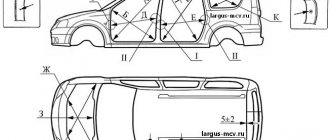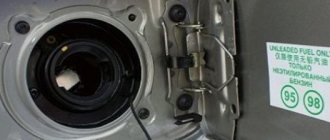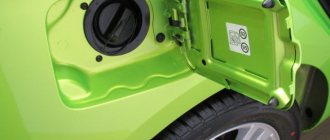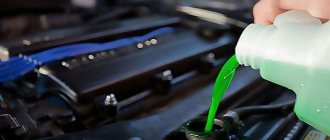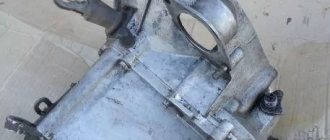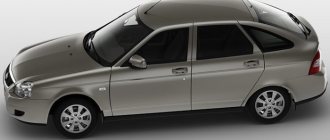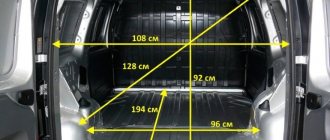Specifications 2114
Before we look at the main question - how much volume the VAZ 2114 tank holds, let’s look at the main technical characteristics of this car.
Its engine parameters are as follows:
- working volume - 1499 cm3;
- total power - 77 hp;
- maximum rotation speed - 5200 min-1;
- maximum torque - 116 N/m.
In turn, the main operating parameters of the VAZ 2114 car look like:
- acceleration time from 0 to 100 km/h - 14 s;
- maximum possible speed - 157 km/h;
- fuel consumption in urban conditions (per 100 km) - 9.9 l;
- fuel consumption on a suburban highway (per 100 km) - 6.2 l;
- fuel consumption when traveling in mixed conditions (per 100 km) - 7.5 liters.
Now consider the main weight and dimensions of the car:
- total length - 4122 mm;
- full width - 1650 mm;
- height - 1422 mm;
- ground clearance - 165 mm;
- wheelbase size - 2460 mm;
- front track - 1400 mm;
- rear track - 1370 mm;
- weight (curb) - 985 kg;
- weight (total) - 1410 kg;
- fuel tank volume (full) - 43 l.
As you can see from the table above, the gas tank on the VAZ 2114 holds exactly 43 liters. Is this really so? Let’s look at it below.
Features of the power unit
The first “fourteenth” VAZ models were equipped with injection engines characterized by a displacement of 1499 cm³ and a power of 57.2 kW. Since 2007, under the hood of the Lada 2114 Samara-2 there was a four-stroke gasoline engine with a displacement of 1599 cm³, providing a power of 59.5 kW or 80 hp. With. This engine met the parameters of the Euro 3 eco-standard. The latest modernized model with the index 211440-24 has a sixteen-valve engine with an output of 89 horsepower.
Sectional view of the power unit
The power supply system using distributive (phased) injection provides high dynamic capabilities, ensuring acceleration to 100 km/h in just 13 seconds. The maximum speed of the VAZ 2114 is 160 km/h. At the same time, the car consumes gasoline economically - only 9 l/100 km in the city.
A special feature of the engine characteristics of this model is the original location of the ceramic catalyst - near the engine itself (unlike its predecessors, which had a catalyst under the bottom). The difference between the cylinder block of the VAZ engine of the “fourteenth” model Lada Samara-2 is its changed volume, achieved by increasing the height of each of the cylinders by 0.23 cm.
Actual tank volume on the 14th model
As mentioned, the manufacturer claims that the volume of the 2114 tank is 43 liters (in some cases you can find a figure of 42.5 liters). And this figure is indeed very close to reality.
At the same time, it is worth considering a number of facts that can significantly affect capacity:
- Errors in the manufacture of the tank.
- Time of year and temperature.
- Fuel system volume.
The first of these factors is usually insignificant. But, as practice shows, sometimes the difference in the volumes of two identical tanks can reach (as a result of low production accuracy) 2 liters. Thus, on some machines the total volume can reach 45 liters (which is extremely rare).
This should also include the difference in weather conditions. In cold weather, the fuel contracts, and in warm weather, it expands. This factor also affects how many liters the tank on a VAZ 2114 can hold (if we take into account the full volume of gasoline that can fit in hot summers and winter frosts, the difference can reach 1.5 liters).
Well, finally, you should remember that the fuel system itself also holds a certain amount of fuel. On average, when the tank is completely empty, up to 2 liters of gasoline can remain in it. As a result of this number of features, the amount of fuel contained in the tank may differ from that declared by the manufacturer, either more or less.
If at a gas station you managed to fill 50 liters of fuel into an almost empty tank, then this can become a good reason to complain about the accuracy of the filling device and the operation of the station itself. Such a large difference in volumes cannot be attributed to any of the above errors.
It is also worth noting that if the vehicle is operated incorrectly and refueled with low-quality fuel, sediment can accumulate at the bottom of the tank, which over time can (albeit insignificantly) reduce its volume. In order to avoid such a situation, the tank should be inspected every few years.
If the warning light on the panel lights up, it means you can fill the tank with up to 35 liters of fuel without fear of it overflowing.
Preventing gas tank contamination
Cleaning the tank from water, dirt and rust with your own hands is quite simple. However, not every car enthusiast wants to do this. You can, of course, turn to professionals, but it costs money. It is much easier to prevent contamination of the tank and corrosion of its walls.
Epoxy against rust
Epoxy resins are used for anti-corrosion treatment of the inner surface of the gas tank. This coating is insoluble in water and gasoline, making it excellent for rust protection. To evenly apply the resin to all the walls of the tank, it must be poured through the neck, and then rotate the tank for a long time. When the epoxy has spread over all the walls of the tank, you can begin drying.
Smart car operation
The most reliable way to prevent contamination and corrosion of a gas tank is proper operation of the vehicle. A set of simple rules that, if followed, will save you from having to clean the gas tank:
- Monitor the quality of the fuel. Refuel only at approved gas stations.
- Monitor the amount of fuel. Try to keep the tank full. Be sure to fill it completely before parking for a long time. This will avoid the accumulation of water in the tank and its condensation on the walls.
- Try not to refuel in high humidity or foggy weather. If you still need to refuel, fill the tank full.
- With the onset of cold weather, add desiccant or alcohol to the tank in small quantities.
If a car's engine is its fiery heart, then the gas tank is its stomach, so it is very important for the health of the car to monitor its condition. Keep your tank clean and fill it with only quality gasoline, and your car will reward you with a smooth ride and long service life.
Consumption and travel distance
If we take into account the volume of the VAZ 2114 tank and the data on gasoline consumption (given in the table above), we can draw the following conclusions about the possible travel range.
When driving at a constant speed of 90 km/h, the maximum range can be almost 700 km without additional refueling.
When traveling in the so-called “mixed” city/highway mode, consumption will increase, which means the range will decrease (up to 640 km).
And when traveling only in city mode (taking into account standing in traffic jams and a large proportion of driving in low gears), fuel consumption will be maximum - almost 10 l/100 km. It is also worth considering that these figures are for new cars. For used cars they will be slightly higher.
How often do you change antifreeze or antifreeze?
To determine when to change antifreeze or antifreeze, you need to consider the following factors:
- Shelf life of antifreeze.
- Manufacturer's recommended coolant mileage when replacing.
- Current state of the liquid: color.
Each coolant has its own expiration date:
- Antifreeze – 2 years.
- Antifreeze - 5 years.
You also need to pay attention to what mileage your coolant is designed for: the bottles always indicate the lifespan of the coolant: it could be 20 thousand, maybe 40 thousand.
Place 21093 in the AvtoVAZ model line
The prototype for the VAZ 21093 was the front-wheel drive hatchback VAZ 2109 “Sputnik”, with a 1.3 liter carburetor engine, produced in Togliatti since 1987. Its engine power was 64 horsepower. Externally, the 21093 Samara, which appeared in 1990, was not much different from the 2109. Dimensions, design, design - everything was almost like the nine. The main differences were hidden under the hood.
Modification 21093 received a new engine. The designers of the Volzhsky Automobile Plant increased the cylinder diameter from 78 to 82 mm with the previous piston stroke of 71 mm. This resulted in an increase in the working volume from 1288 cubic cm to 1499. The car's power increased, its performance characteristics improved (speed and acceleration dynamics), and fuel consumption decreased slightly. In general, the VAZ 21093 car has acquired noticeable liveliness.
Improved aerodynamics
The VAZ 2114 car excels in aerodynamic characteristics thanks to its well-designed body lines, providing excellent streamlining. As a result of the change in appearance, the drag coefficient has decreased.
External aerodynamic improvements of the Lada2114 Samara-2 also affected changes in the position of the air flow separation point. To do this, the designers had to change the angle of inclination of the most aerodynamically active front part of the car - the hood. The front fenders have also undergone changes.
Power plant of the VAZ 2114 car
As a result of the redistribution of the air flow, a smaller part of it is directed under the bottom, while the larger part is directed onto the hood and spreads over the body. These characteristics change the amount of total lift force, as a result of which the front and rear axles are unloaded. The even distribution of lift force allows the hatchback to behave in a balanced manner during high-speed driving.
Body and interior of VAZ 21093
Over the years of production of modification 21093, some changes have occurred in the design while maintaining the same body dimensions. The body of the ninety-third is a five-door hatchback, its front part and radiator have been updated, and a short wing has appeared. The overall and internal dimensions of models 2109 and 21093 are the same down to the millimeter. The interior of car 21093 is five-seater, but it is difficult for three large men to fit in the back. The rear row of seats folds down, almost doubling the trunk volume (from 330 liters to 640 liters).
Main dimensions of the Lada 21093 car.
The luxury package had an improved dashboard with a tachometer and an on-board computer, and it was possible to install electric windows and an anti-theft system. Several options were offered for the upholstery and seats: from the most unassuming gray textiles to higher quality colored materials. The interior of the ninety-third was comfortable and practical both for daily trips to work and for relatively long trips with children.
VAZ 2115 configurations
Self-replacement of the VAZ 2115 speed sensor
This popular descendant of the VAZ 21099, a prominent representative of the Samara-2 family, is a compact B class sedan.
Produced from 1997 to 2012 in three main trim levels:
- “Standard” VAZ 21150-20-ST;
- “Norma” VAZ 21150-21-NR;
- "Lux" VAZ 21150-22-LX.
The 20-ST package did not include any additional elements or options other than standard seat belts and electric door locks. The interior is without any special decorative details, with tweed seat upholstery and solid fabric inserts on the side panels.
With the advent of the “21–NR” (standard) configuration, the car was equipped with fog lights, seat belt warning lights and heated front seats. The electrical equipment was supplemented with front door window lifts.
The most equipped car was the Luxury class car (22-LX). In addition to everything that was in previous trim levels, buyers now have a choice of interior trims. The seat upholstery was made not only of tweed material, but also of velvet.
The level of car safety has increased thanks to the built-in ABS (anti-lock braking system). Installing power steering made the car easy to control and maneuverable.
In addition there were:
- rear side window lifts;
- heated rear seats;
- headlight cleaners;
- factory tinted windows.
How much does an empty gas tank from a VAZ 2114-2115 weigh? In kilograms. Can I take it off alone?
BODY Body type Sedan Number of doors 4 Number of seats 5 Length 4330 mm Width 1970 mm Height 1402 mm Wheelbase 2460 mm Front track 1400 mm Rear track 1370 mm Ground clearance 170 mm Maximum trunk volume 427 l ENGINE Engine location Front, transverse Engine capacity 1596 cm3 Power 81 l. With.
At rpm 5200 Torque 120/2700 n*m Power system Distributed injection Presence of turbocharging - Gas distribution mechanism - Cylinder arrangement In-line Number of cylinders 4 Number of valves per cylinder 2 Fuel AI-95 TRANSMISSION Drive Front Number of gears (mechanical transmission) 5 SUSPENSION Type front suspension Independent McPherson type Rear suspension type Trailing arm BRAKE SYSTEM Front brakes Disc Rear brakes Drum PERFORMANCE INDICATORS Maximum speed 158 km/h Acceleration time (0-100 km/h) 13.2 s Fuel consumption on the highway 7.6 l/100 km Fuel tank capacity 43 l Vehicle curb weight 985 kg Tire size 165/70 R13; 175/70 R13
Like all VAZs - 43 liters. to capacity!
93 engine options
There are two engine options for the 21093:
- carburetor VAZ 21083;
- injection VAZ 2111.
Both engines are in-line, four-cylinder, eight-valve and have a displacement of 1499 cm3. The motors are located transversely at the front. Their cylinder diameter and piston stroke are the same, and the compression ratio is 9.9. The engines consume gasoline: carburetor - AI-93, injection - AI-95. The fuel tank capacity is the same - 43 liters.
The VAZ 21083 engine on the VAZ 21093 carburetor model develops maximum power of 70 horsepower at 5600 rpm, and torque is 104 Nm at 3400 rpm. The maximum speed is 154 km/h, the engine accelerates the car to 100 km/h in 13.4 s. Fuel consumption of the VAZ 21093 per 100 km in the city is 8 liters, outside the city - 5.7 liters, in the combined cycle - 6.8 liters. The curb weight is 915 kg.
In 1994, an injector version of the VAZ 21093 was released, designated VAZ 21093i. The technical characteristics of the VAZ 21093i have changed for the better. Engine power increased to 78 horsepower at 5400 rpm, torque was 116 Nm at 3000 rpm. Acceleration time to 100 km decreased to 13 s.
Engines of different sizes and power can be installed under the hood of a hatchback. The first models were equipped with a four-cylinder, eight-valve engine, the volume of which was 1100 cc. cm. In subsequent models, this figure increased by 1300 cc. cm, and later reached 1500. In the 90s, a model with an injection engine was also released.
FEATURES OF 8 AND 16 VALVE MODELS
VAZ 2114: replacing coolant
The 2114 model range is represented by two factory modifications: the classic “Samara”, which was produced from 2001 to 2013, and “Super-Auto”, produced by a VAZ subsidiary - Super-Avto CJSC, the supply of which to the market began in 2010 and continue to this day.
These modifications differ in their power unit: the “Samara” has an engine with 8 valves, the “Super-Auto” has an engine with 16 valves, which is equipped as stock in the “Lada Priora”.
Visually determining which engine is installed on the fourteenth is only possible for professionals, or those who are well versed in the VAZ model range, since externally they have only one difference - wheel rims of different diameters: the 8v has thirteen-inch wheels, the 16v has fourteen-inch wheels.
All the main differences lie in the power units, which are similar in only one way - displacement; both models have 1.6-liter engines.
Let's go over the main advantages of the model with a 16v engine:
- The maximum power of the 16v engine is 66 kW, which provides 5000 rpm, while the 8v 60 kW engine produces 5200 rpm;
- If we translate these characteristics into horsepower, then in 16v – 90 horses, and in 8v – 81;
- In addition, in the 16v power unit, the combustion efficiency of the fuel mixture has been significantly improved; in the 16-valve 14th, the consumption per 100 km is 7 liters, in the 8v model – 7.6 l/100km;
- The 16v engine also has the best torque (Nm) - 131/3700 min, for the 8v - 120/2700 min, which is why the acceleration performance of the sixteen valve engine is much superior to the 8v - 11.2 and 13.2 seconds to hundreds, respectively;
- Maximum speed 16v – 190 km/h, 8v – 160 km/h.
It is also worth noting that the VAZ 2114 with a 16v engine holds the roadway much more confidently due to the improved suspension - the car is equipped with energy-intensive shock absorbers and improved struts.
VAZ 2114 1.6i - conversion from 8v to 16v with priority and shafts
This concludes the review of the fourteenth.
Transmission and chassis of the VAZ 21093
The transmission on the VAZ 21093 is structurally made of one unit, including a clutch and a manual gearbox (MT). The gearbox is combined with a differential, the clutch is single-plate. The clutch housing is connected to the flywheel with bolts. To ensure contact with the pressure plate, six elastic plates are used.
The car's wheel drive includes two constant velocity joints (CV joints): a rod shaft on the left and a tubular shaft on the right. The front suspension of the car is independent, hydraulic shock absorbers, cylindrical springs. The rear suspension is torsion bar, independent, with a trailing arm design.
The braking system on the 21093 uses front disc brakes and rear drum brakes. There is a diagonal interaction of contours. One circuit includes the right front and left rear wheels, the other - the remaining two. The hydraulic drive of the system includes a vacuum booster and a pressure regulator for the rear brakes.
The VAZ 2109 was first produced back in 1988. The five-door design allowed this car to be used as a successful family commercial vehicle. At the same time, the car is often used for transporting small-sized cargo, as it is equipped with a fairly simple luggage compartment.
Due to the fact that the VAZ 2109 is a very practical and easy-to-maintain car, it is popular among young people. Due to its distinctive sporty look and great lightness, it is ideal for tuning enthusiasts. Modernization in this area includes not only a transformation of the appearance, but also engine tuning. Sports riding enthusiasts change the following:
- basic bumpers - for stylish sports body kits,
- install powerful, direct-flow exhaust pipes,
- standard air filters - for sports ones.
The car gains improved aerodynamic properties and increased power. But tuning fans don’t stop there and upgrade the engine in a sporty way. Today you can often find VAZ 2109 with turbine engines, which take part in street racing along with foreign cars.
Another way to tune a VAZ 2109 is to replace the car’s dashboard. In configuration, it is similar to panels of such brands as BMW 3, Mazda 626, Opel Vectra. They are so suitable in configuration that they do not undergo any modifications before installation in the “nine”. Anyone who plans to do this will replace the dashboard of any problems.
The VAZ 2109, the price of which is affordable for everyone, has proven itself well on the Russian market. And despite the fact that the production of the “nine” has completely stopped since 2011, it is still in high demand. To make the car more interesting, you will have to spend money, but after tuning it will be difficult to recognize it as a VAZ 2109.
The production of the VAZ-2109 car began in 1988 by the Volzhsky Automobile Plant. Its predecessor was the VAZ-2108, compared to which the body of the “nine” became more elongated, and there were two more doors (five). Thanks to the increased number of doors, many people used it as a family car.
The interior of the VAZ-2109 is strictly practical and claims to be comfortable. In the first case, we should note the laconic “low” dashboard, which is somehow a little convenient. The front seats have headrests. In the second case, it is worth noting the informative “high” dashboard, thanks to which you can clearly monitor the status of its on-board systems.
And thanks to the improved interior (door upholstery with rates, fabric seat upholstery), the car can acquire a more prestigious look. If you fold the rear seats, this car takes on a cargo-passenger appearance, like a station wagon.
The last cosmetic upgrade for this car was made in 1997. Since 2001, they began to produce them with injection engines. Maintenance of this car is almost as economical as for other models of the Volzhsky Automobile Plant.
Installing spacers for front shock absorbers
To begin with, we will look at how to raise the front of a VAZ 2114. But before you start increasing the car’s ground clearance, you should prepare all the necessary tools. So, you will need a set of keys, a hammer, as well as a lift or inspection hole (without them it will not be possible to complete the installation procedure).
The process of installing spacers is carried out in the following order:
- Place the car in the pit.
- Raise the front end using a jack.
- Remove the tie rod pin from the front strut (you may need a hammer and pry bar for this).
After the ground clearance of the front rings has been increased, spacers should also be installed under the rear pillars.
Installation of spacers under the rear shock absorbers is carried out according to the following scheme:
- Unscrew the fasteners of the lower part of the shock absorber.
By carrying out such a simple operation, you can significantly increase the vehicle's ground clearance in just a couple of hours compared to the factory version.
It should also be noted that after the changes have been made, the car should have the following toe-in/camber angles (with a load of 4 adults in the cabin and 40 kg of payload in the trunk):
- camber - 0°±30';
- toe - 0°00'±10' (0±1 mm);
- castor (rotation axis angle) - 1°30'±30'.
Without load, these same values must be within the following limits:
- camber — 0°30'±30';
- toe - 0°15'±10' (1.5±1 mm);
- castor - 0°20'±30'.
If the specified parameters go beyond the above acceptable limits, then you cannot operate the car - you should correct them yourself or at a service station.
How many liters of gasoline are in the tank of a VAZ 2114
What is the volume of the fuel tank of the VAZ 2114?
- Is it normal or not when the revs drop when the lights are turned on? – 4 answers
- Overflow or is this normal, VAZ 2115? – 3 answers
- The fuel pump hums before turning off on a VAZ 2109 - 3 answers
- VAZ 2115 troits, does not move - 3 answers
- Why does the VAZ 2115 take a long time to start after a short stop? – 3 answers
The nominal volume of the fuel tank of the VAZ 2114 is 42.5 liters .
You can top it up, as they say, under the cap. Those. When the filling nozzle cuts off, you can press the regulators and carefully, in small portions, add a few more liters. But you need to be careful, especially in the summer, when gasoline expands from the heat.
Considering that gasoline consumption per 100 km (at a speed of 90 km/h) is approximately 5.7 liters, then on a full tank you can travel more than 700 km. without refueling.
But if you drive at 120 km/h, the consumption increases by 7.8 liters, and in urban conditions even more - 8.9. Accordingly, the distance traveled will be shorter.
Post edited by TEMbI4: 10/06/2010 — 21:28
- Megatheronosaurus
- Group: Disabled
- Posts: 8,690
Post edited by kkvvnn: 10/06/2010 — 17:48
tell me how many liters the tank is 2114. The volume of the tank is VAZ 2114.
Similar articles
20 comments on “Tank volume of VAZ 2114. How many liters of tank 2114”
43, but I poured it into a dry tank up to my throat, it came out around 48 liters
43 liters according to the book.
someone has a rubber tank!
43 but you can fill in 47
please tell me VAZ 21053 there was a problem with the 4th cylinder, either the roofing felt valve burned out or something else, in general it was shooting and the car was barely moving, the problem was fixed, but now the consumption has increased threefold, that is, about 25 liters per hundred, I don’t know where to dig, maybe someone can give advice ?? Is such a flow rate possible due to the valves? Or is the carburetor at fault?
And that everything is possible, I drove a Kamaz there, according to the documents, the tank is 200 liters and it almost fits on a dry tank of 230, but if you think about it, it’s all 240
So, if you pour it all the way down, everything is possible))) I’ve also had gasoline escape through the neck)))
Well, in general, you can fill the engine with oil up to the top. only if you start - 3.14 for all seals. It is better not to exceed your passport data. You also take into account physics - when heated, expansion occurs, and where does gasoline go if everything is filled under the gas tank cap?
Misha, that’s why there is a plastic box over the neck that prevents vacuum from forming. It’s on the classics that the car starts to run worse, the later ones have already thought about it.
Aidar, well, according to this principle, antifreeze can be poured under the lid, there is also a valve for releasing gases
Misha, is there a Min or Max mark and a dipstick in the tank?
Aidar, tidying up for whom? If anyone didn’t know, the rightmost sensor shows the level there. and every literate person will inquire and know the volume of their gas tank, which can be easily found on the Internet if there is no service book
Misha, only the sensor shows full when the tank is full, but the fact that there is a tube going up to the neck, where a couple of liters can still fit, is not there. And no, not everyone. This sensor also beeps, at least by a couple of liters.
Aidar, in general it is clear that there are problems with physics, further dispute is pointless
COMPONENTS OF THE FUEL SYSTEM
The VAZ 2114 fuel system consists of the following main elements:
- Gas tank;
- Fuel pump;
- Gasoline filtration devices;
- Pipeline system;
- Fuel rail;
- Injectors;
- Waste disposal unit.
Fuel system diagram
Let's analyze each component separately.
GAS TANK
The VAZ 2114 gas tank is a container made of two equal metal parts. A neck is removed from the tank into which gasoline is poured. The neck is connected to the tank via a rubber pipe and clamps.
FUEL PUMP
The fuel pump is located directly in the tank. It has a fuel level sensor, which transmits information about the current amount of gasoline to the ECU. The gasoline pump is connected to a line through which gasoline is transported to the fuel rail. The fuel pump itself consists of several parts - coarse filters, wiring and an electric motor, which pumps fuel. As evidenced by reviews from owners of fourteenth cars, fuel pumps from the German company BOSCH have proven themselves to be the best.
FILTRATION DEVICE
The VAZ 2114 fuel injection system very much depends on the quality of the filter devices used. A bad filter will significantly reduce both the efficiency and the longevity of the entire system.
On the fourteenth, non-separable filters with a working element made of paper are installed. Such filters clog quite quickly, and they need to be changed at least once every 10-15 thousand kilometers.
FUEL RAIL
The fuel rail is located on the intake manifold housing. Its design consists of two parts, separated by a spring-loaded diaphragm. The first is the fuel one, in which the required level of gasoline pressure is set, the second is the air one, air is pumped into it, due to which the diaphragm compresses the fuel chamber and changes the pressure level in it.
Ramp
PIPING AND HOSES SYSTEM
To circulate gasoline from the gas tank to the injectors, the fourteenth uses steel fuel lines located on the bottom of the car. The VAZ 2114 fuel supply system also provides for a return pipeline through which excess gasoline from the injectors is returned back to the gas tank.
VAZ 2114 owners are advised to carefully monitor the condition of the fuel line in order to avoid gasoline leaks. Pipes should be checked regularly for deformation and corrosion.
INJECTORS
Injectors are valves actuated by electromagnetic control. They have a sprayer, with the help of which fuel under pressure is supplied directly to the combustion chambers.
Injectors are one of the most problematic parts of the fuel supply system of the fourteenth (as well as VAZ 2115 and VAZ 2113), the service life of which directly depends on the quality of the gasoline used. If the fine filter does not fully perform its functions, the injectors will become clogged, and from time to time you will need to clean them at a service station (doing this at home is very problematic).
A critical failure of the injectors is a short circuit or break in the winding, after which it is necessary to replace the failed part.
WASTE DISPOSAL UNIT
The EURO-3 environmental safety standard, to which the VAZ 2114 complies, provides for the presence of a gasoline vapor recovery chamber, for which the fourteenth uses an adsorber with activated carbon. The adsorber is connected to a throttle assembly, from which all resulting vapors are sucked out.
Adsorber
How many liters of gasoline are in the tank of a VAZ 2114
What is the volume of the fuel tank of the VAZ 2114?
- Is it normal or not when the revs drop when the lights are turned on? – 4 answers
- Overflow or is this normal, VAZ 2115? – 3 answers
- The fuel pump hums before turning off on a VAZ 2109 - 3 answers
- VAZ 2115 troits, does not move - 3 answers
- Why does the VAZ 2115 take a long time to start after a short stop? – 3 answers
The nominal volume of the fuel tank of the VAZ 2114 is 42.5 liters .
You can top it up, as they say, under the cap. Those. When the filling nozzle cuts off, you can press the regulators and carefully, in small portions, add a few more liters. But you need to be careful, especially in the summer, when gasoline expands from the heat.
Considering that gasoline consumption per 100 km (at a speed of 90 km/h) is approximately 5.7 liters, then on a full tank you can travel more than 700 km. without refueling.
But if you drive at 120 km/h, the consumption increases by 7.8 liters, and in urban conditions even more - 8.9. Accordingly, the distance traveled will be shorter.
Post edited by TEMbI4: 10/06/2010 – 21:28
- Megatheronosaurus
- Group: Disabled
- Posts: 8,690
Post edited by kkvvnn: 10/06/2010 – 17:48
tell me how many liters the tank is 2114. The volume of the tank is VAZ 2114.
Similar articles
20 comments on “Tank volume of VAZ 2114. How many liters of tank 2114”
43, but I poured it into a dry tank up to my throat, it came out around 48 liters
43 liters according to the book.
someone has a rubber tank!
43 but you can fill in 47
please tell me VAZ 21053 there was a problem with the 4th cylinder, either the roofing felt valve burned out or something else, in general it was shooting and the car was barely moving, the problem was fixed, but now the consumption has increased threefold, that is, about 25 liters per hundred, I don’t know where to dig, maybe someone can give advice ?? Is such a flow rate possible due to the valves? Or is the carburetor at fault?
And that everything is possible, I drove a Kamaz there, according to the documents, the tank is 200 liters and it almost fits on a dry tank of 230, but if you think about it, it’s all 240
So, if you pour it all the way down, everything is possible))) I’ve also had gasoline escape through the neck)))
Well, in general, you can fill the engine with oil up to the top. only if you start - 3.14 for all seals. It is better not to exceed your passport data. You also take into account physics - when heated, expansion occurs, and where does gasoline go if everything is filled under the gas tank cap?
Misha, that’s why there is a plastic box over the neck that prevents vacuum from forming. It’s on the classics that the car starts to run worse, the later ones have already thought about it.
Aidar, well, according to this principle, antifreeze can be poured under the lid, there is also a valve for releasing gases
Misha, is there a Min or Max mark and a dipstick in the tank?
Aidar, tidying up for whom? If anyone didn’t know, the rightmost sensor shows the level there. and every literate person will inquire and know the volume of their gas tank, which can be easily found on the Internet if there is no service book
tank volume, how much gasoline fits in the fuel tank?
The volume of the fuel tank in the car primarily determines the number of kilometers that can be driven without refueling. You need to know this if you are going on a long trip or spend a lot of time moving around the city. A car enthusiast needs to be able to plan his route in such a way as to be able to visit a gas station in a timely manner. Let's tell you what the volume of the tank is in a VAZ-2115 car.
Tank volume and why it changes
According to the technical documentation for the VAZ-2115, this car has a fuel tank with a nominal volume of 43 liters. However, its design feature is a long neck, into which you can pour another 2 to 5 liters. There is a fierce debate among car enthusiasts over how many liters can actually be placed in the tank of a standard “tag”. Many even believe that in cold weather a larger amount of fuel can be placed in the container than on a hot summer day.
In fact, the reason for the change in the holding volume of fuel is the deformation or stretching of the tank. If the surface of this spare car part has many dents, then its capacity will decrease. Over time, some car enthusiasts begin to notice that more gasoline is placed in the tank for refueling the car; this is due to the swelling of the tank.
It is unknown what the displacement will be in the latter case, but in practice, service station specialists have encountered tanks with a capacity of 50 liters (excluding the neck).
Problems of the VAZ-2115 fuel tank
The gasoline tank on the VAZ-2115, as in any other car model, is made of metal. This material tends to stretch and compress under the influence of external forces. This is far from the only problem with fuel capacity in this car. Most often, owners of this vehicle encounter the following problems:
- fuel leakage;
- incorrect operation of the sensor;
- design flaws.
The first and last faults are often related. The fact is that in carburetor models a separator is used. This device is necessary to collect gasoline vapors and condense them. After the vapor turns into liquid, it is drained back into the tank. Most VAZ-2115s are equipped with a plastic separator, which over time becomes covered with cracks, melts and becomes deformed. In such cases, it is necessary to replace it with a metal model, which is more resistant to external influences. The injector does not have such an element in its design.
Incorrect display of the fuel level in the tank can be caused by two reasons:
- If, after starting the engine, the instrument on the panel shows different values, then you need to look for a problem in the handbrake area. There is a ground wire running through it, the fastening of which may become loose when the vehicle is used. It is enough to tighten two bolts for the problem to disappear.
- After repairs, the gasoline consumption control lamp may come on prematurely. This is due to the fact that the float sensor located in the fuel container is triggered ahead of time. At the moment when the float drops to a certain level, the contacts close. It is enough to bend the limit switch slightly so that the closure occurs a little later.
Remember that all work on the fuel system must be carried out in compliance with safety rules.
VESKO-TRANS.RU
AutoNews / Reviews / Tests
How many liters of gasoline are in the tank of VAZ 2115
Fuel tank volume on a VAZ-2115
From the volume of the fuel tank
a car primarily depends on the number of kilometers that can be driven without refueling. You should know this if you are traveling a long way or if you are traveling to a specific destination for a significant period of time. The car owner must be able to independently plan his route so that he can visit the gas station on time. We will tell you how much the VAZ-2115 tank costs.
Tank volume and why it changes
According to the technical documentation for the VAZ-2115, a 43-liter fuel tank is installed here. But its design feature is a long neck, into which you can pour another 5 - 5 liters. There are heated debates among car owners about whether they exist. How many
I did place a standard "tag" in the tank. They probably even think there is more fuel in the tank than on a hot summer day.
In fact, the deformation or tension of the reservoir is a prerequisite for the configuration of the deposited fuel volume. If the surface of this spare car parts has a huge number of dents, then its capacity will decrease. Over time, some car owners begin to notice that not only gasoline is filled into the gas station; this is associated with pumping up the gas tank.
What the bias would be in the latter case is unclear, but almost 100 experts came across 50-liter tanks. (regardless of the neck).
Problems with fuel VAZ-2115 tank
Gasoline container
on the VAZ
2115
, as in other metal car models. This material has the property of stretching and shrinking under the influence of external forces. This is by no means the only problem with your car's fuel tank. As a rule, owners of this car face the following problems:
- fuel leak;
- incorrect operation of the sensor;
- construction defects.
The first and last faults are often interconnected. There is a carburetor model that uses a separator. This device is required to collect and condense gas vapors. If the vapor turns to liquid, it is reconnected to the tank. A plastic separator is installed in the main part of the VAZ-2115, which cracks, melts and deforms over time. In this case, you need to replace it with an iron model that is more resistant to external influences. The injector does not have such an element in its design.
https://youtube.com/watch?v=kDsZ23eUKGc
Fuel tank capacity. experiment
What is the actual amount of fuel tank
car. I tried to understand this personally.
https://youtube.com/watch?v=rBbrflcwfqk
Replacing fuel tanker (VAZ 2115)
Changing fuel tank
(
VAZ 2115
) Evgeniy and Nikita will show you how to replace the fuel
tank
Do it yourself. Channel.
There are two reasons why the fuel level in the tank may not be displayed correctly:
- If the gauge shows different readings after starting the engine, look for a parking brake problem. There is a ground wire that can be unscrewed when using the car. It is enough to tighten two bolts for the problem to disappear.
- After repairs, the gas indicator may come on prematurely. This is because the float switch located in the fuel tank operates early. As soon as the float drops to a certain level, the contacts close. It is enough to bend the trailer a little so that the blocking occurs a little later.
Remember that all operations with the fuel system must be performed in accordance with safety regulations.
What to do if water enters the tank
The amount of gasoline filled may become smaller if liquid accumulates in the tank. The container parameters do not change, but the composition of its contents will be different. If water gets into the tank, you may observe the following:
- difficulty driving in the morning;
- uneven engine operation;
- you need to warm up the car longer than you start.
Water enters the reservoir for various reasons. You can remove it in one of the following ways:
You can prevent water from entering the tank by maintaining a constant fuel level (preferably fill up to the eyeballs). If you need to top up your gas
On a rainy or foggy day, fill the fuel tank 100%. This simple technique will allow the system to remove moist air that is trapped by condensation while driving. In late autumn, pour pure alcohol into the system (200 milliliters is enough) to remove accumulated water and prevent it from freezing.
How many liters are in the gas tank of the 2115?
BODY Body type Sedan Number of doors 4 Number of seats 5 Length 4330 mm Width 1970 mm Height 1402 mm Wheelbase 2460 mm Front track 1400 mm Rear track 1370 mm Ground clearance 170 mm Maximum trunk volume 427 l ENGINE Engine location Front, transverse Engine capacity 1596 cm3 Power 81 l. With. At rpm 5200 Torque 120/2700 n*m Power system Distributed injection Presence of turbocharging – Gas distribution mechanism – Cylinder arrangement In-line Number of cylinders 4 Number of valves per cylinder 2 Fuel AI-95 TRANSMISSION Drive Front Number of gears (mechanical transmission) 5 SUSPENSION Type front suspension Independent McPherson type Rear suspension type Trailing arm BRAKE SYSTEM Front brakes Disc Rear brakes Drum PERFORMANCE INDICATORS Maximum speed 158 km/h Acceleration time (0-100 km/h) 13.2 s Fuel consumption on the highway 7.6 l/100 km Fuel tank capacity 43 l Vehicle curb weight 985 kg Tire size 165/70 R13; 175/70 R13
Like all VAZs - 43 liters. to capacity!
according to passport 42_5
Today I looked at half the tank
